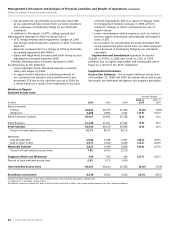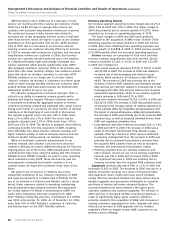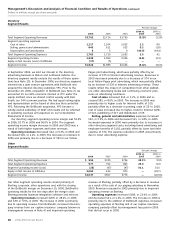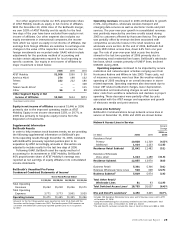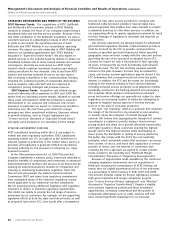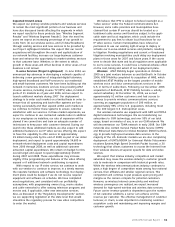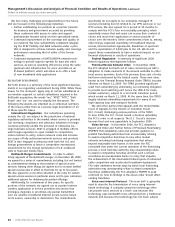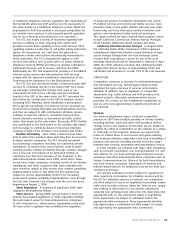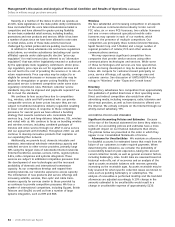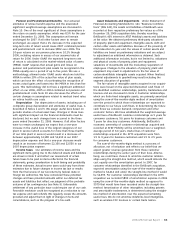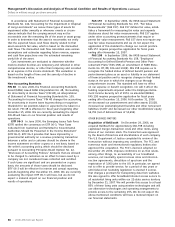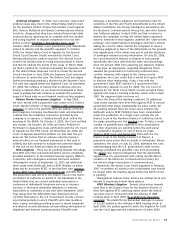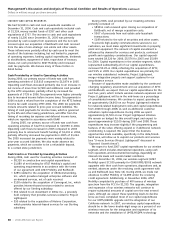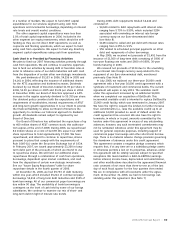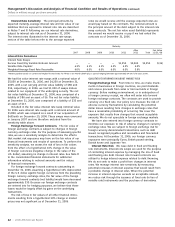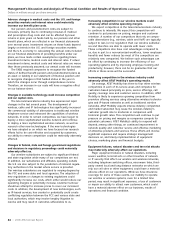AT&T Wireless 2006 Annual Report Download - page 36
Download and view the complete annual report
Please find page 36 of the 2006 AT&T Wireless annual report below. You can navigate through the pages in the report by either clicking on the pages listed below, or by using the keyword search tool below to find specific information within the annual report.
34 : :
2006 AT&T Annual Report
Management’s Discussion and Analysis of Financial Condition and Results of Operations (continued)
Dollars in millions except per share amounts
Recently, in a number of the states in which we operate as
an ILEC, state legislatures or the state public utility commissions
have concluded that the voice telecommunications market is
competitive and have allowed for greater pricing flexibility
for non-basic residential retail services, including bundles,
promotions and new products and services. While it has been
a number of years since we have been allowed to raise rates
in certain states, some of these state actions have been
challenged by certain parties and are pending court review.
In addition to these wholesale rate and service regulations
noted above, our wireline subsidiaries (excluding rural carrier
affiliates) operate under state-specific elective “price-cap
regulation” for retail services (also referred to as “alternative
regulation”) that was either legislatively enacted or authorized
by the appropriate state regulatory commission. Under price-
cap regulation, price caps are set for regulated services and
are not tied to the cost of providing the services or to rate-of-
return requirements. Price cap-rates may be subject to or
eligible for annual decreases or increases and also may be
eligible for deregulation or greater pricing flexibility if the
associated service is deemed competitive under some state
regulatory commission rules. Minimum customer service
standards may also be imposed and payments required if we
fail to meet the standards.
We continue to lose access lines due to competitors
(e.g., wireless, cable and VoIP providers) who can provide
comparable services at lower prices because they are not
subject to traditional telephone industry regulation resulting
in lower cost structures. In response to these competitive
pressures, for several years we have utilized a bundling
strategy that rewards customers who consolidate their
services (e.g., local and long-distance telephone, DSL, wireless
and video) with us. We continue to focus on bundling wireline
and wireless services, including combined packages of
minutes and video service through our AT&T U-verse service
and our agreement with EchoStar. Throughout 2007, we will
continue to develop innovative products that capitalize on
our expanding fiber network.
Additionally, we provide local, domestic intrastate and
interstate, international wholesale networking capacity and
switched services to other service providers, primarily large
ISPs using the largest class of nationwide Internet networks
(Internet backbone), wireless carriers, CLECs, regional phone
ILECs, cable companies and systems integrators. These
services are subject to additional competitive pressures from
the development of new technologies and the increased
availability of domestic and international transmission
capacity. As our competitors develop and expand their
existing networks, our networks experience excess capacity.
The introduction of new products and service offerings and
increasing satellite, wireless, fiber-optic and cable trans-
mission capacity for services similar to those provided by
us continues to provide competitive pressures. We face a
number of international competitors, including Equant, British
Telecom and SingTel; as well as from a number of large
systems integrators, such as IBM and EDS.
Wireless
We face substantial and increasing competition in all aspects
of the wireless communications industry. Under current
FCC rules, six or more PCS licensees, two cellular licensees
and one or more enhanced specialized mobile radio
licensees may operate in each of our markets, which
results in the presence of multiple competitors. Our
competitors are principally three national (Verizon Wireless,
Sprint Nextel Corp. and T-Mobile) and a larger number of
regional providers of cellular, PCS and other wireless
communications services.
We may experience significant competition from
companies that provide similar services using other
communications technologies and services. While some
of these technologies and services are now operational,
others are being developed or may be developed in the
future. We compete for customers based principally on
price, service offerings, call quality, coverage area and
customer service. See discussion of UMTS/HSDPA tech-
nology in “Wireless” under “Expected Growth Areas.”
Directory
Our directory subsidiaries face competition from approximately
100 publishers of printed directories in their operating areas.
Direct and indirect competition also exists from other
advertising media, including newspapers, radio, television and
direct-mail providers, as well as from directories offered over
the Internet. We actively compete on the Internet through our
wholly-owned subsidiary, YPC.
ACCO UNT I NG PO LIC IES A N D STA NDARD S
Significant Accounting Policies and Estimates Because
of the size of the financial statement line items they relate to,
some of our accounting policies and estimates have a more
significant impact on our financial statements than others.
The policies below are presented in the order in which they
appear in our Consolidated Statements of Income.
Allowance for Uncollectibles We maintain an allowance
for doubtful accounts for estimated losses that result from the
failure of our customers to make required payments. When
determining the allowance, we consider the probability of
recoverability based on past experience, taking into account
current collection trends; as well as general economic factors,
including bankruptcy rates. Credit risks are assessed based on
historical write-offs, net of recoveries and an analysis of the
aged accounts receivable balances with reserves generally
increasing as the receivable ages. Accounts receivable may be
fully reserved for when specific collection issues are known to
exist, such as pending bankruptcy or catastrophes. The
analysis of receivables is performed monthly and the bad debt
allowances are adjusted accordingly. A 10% change in the
amounts estimated to be uncollectible would result in a
change in uncollectible expense of approximately $130.


